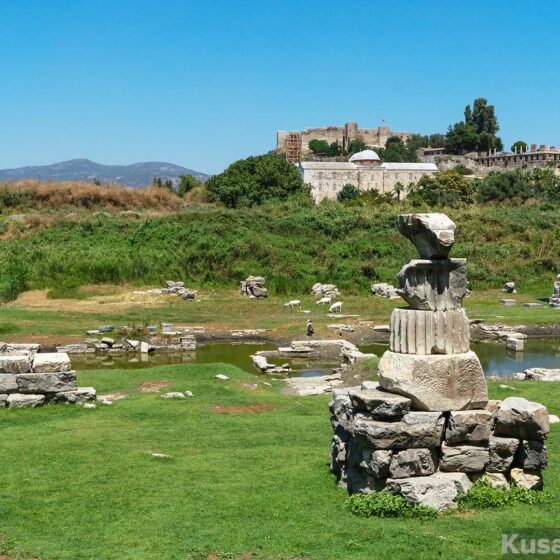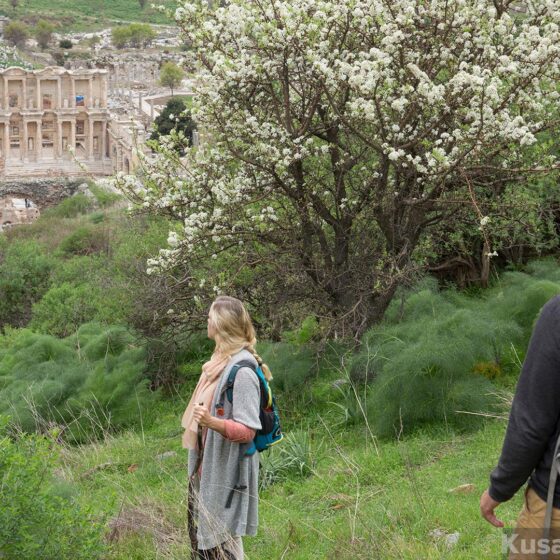Table of Contents Show
Ephesus once a bustling metropolis of the ancient world, remains a beacon for those seeking to connect with history. Among its many ruins, the ancient Latrines offer a unique lens through which we can view Roman society and its architectural achievements.
This post will take you through the history, cultural significance, and the reasons why a visit to these ancient restrooms is indispensable for understanding the sophistication of Roman life.
Chapter 1: The Historical Tapestry of Ephesus
Ephesus, situated in present-day Turkey, was a hub of commerce, religion, and culture. Founded in the 10th century BC, it flourished under Roman rule from the 1st century BC until the 3rd century AD. The city was famed for the Temple of Artemis, one of the Seven Wonders of the Ancient World, and served as a critical port along the Mediterranean trade routes.
See also: Discover Ephesus: Book Your Ephesus Tour Today
Within this historical context, the construction of the public Latrines in the 1st century AD under Emperor Domitian’s reign was a testament to the Roman Empire’s wealth, technological prowess, and social organization. Designed for public use, these facilities were not merely functional but also a space where citizens could socialize, exchange news, and conduct business.
Chapter 2: Architectural Marvels and Social Hubs
The Latrines were engineered with precision, capable of accommodating up to 48 individuals at once. The structure was equipped with a sophisticated sewage system, ensuring sanitation and hygiene, centuries ahead of its time. The seating area, arranged in a U-shape and crafted from marble, offered comfort and durability. A central canal supplied running water, a feature that highlighted the Romans’ advanced understanding of water management.
But beyond their architectural significance, the Latrines served as a vibrant social hub. In the absence of modern privacy norms, these communal spaces fostered a sense of community and egalitarianism, as citizens from various walks of life gathered in these shared quarters.
See also: 7 Churches of Revelation: Tailored Tours in Turkey
Chapter 3: Unearthing the Cultural Significance
The existence and elaborate design of the Latrines underscore the Roman Empire’s emphasis on public health, urban planning, and communal welfare. Such public facilities were rare in the ancient world, making the Latrines of Ephesus an invaluable archaeological find. They provide a window into the daily lives of Romans, revealing how advanced societal structures and public amenities were integral to the empire’s success.
Moreover, the Latrines reflect the Roman philosophy of shared public spaces contributing to the city’s social and economic fabric. This aspect of Roman life offers a fascinating contrast to modern perspectives on privacy and social interaction, inviting visitors to reconsider contemporary societal norms.
Chapter 4: The Latrines Today: A Must-Visit Site
Today, the Latrines stand as a poignant reminder of Ephesus’s grandeur. Preserved meticulously, they offer visitors a tangible connection to the past. Walking through these ancient restrooms, one can almost hear the echoes of Roman citizens engaging in lively conversations, a testament to the vibrant community life that once flourished in Ephesus.
For historians, archaeologists, and casual tourists alike, the Latrines are a must-see. They not only exemplify Roman engineering and urban planning but also serve as a social narrative, providing insights into the communal aspects of Roman life.
Chapter 5: Visiting the Latrines
Visiting the Latrines is an experience that transcends time. As you walk through the archaeological site, guided tours offer insights into the construction techniques, the materials used, and the daily operations of these ancient facilities. Informational plaques and augmented reality apps bring the past to life, allowing visitors to visualize the Latrines in their full operational glory.
Moreover, the Ephesus Museum nearby enriches this experience with artefacts recovered from the site, including tools, coins, and personal items, painting a fuller picture of Roman daily life. This holistic approach to exploring the Latrines and Ephesus provides a comprehensive understanding of ancient Roman civilization.
Chapter 6: Beyond the Latrines: Exploring Ephesus
While the Latrines are a highlight, Ephesus is replete with other monumental structures and ruins that narrate the city’s storied past. Library of Celsus, with its imposing facade, once housed thousands of scrolls and stands as a symbol of the city’s intellectual heritage. The Great Theatre, capable of seating 25,000 spectators, showcases the Romans’ love for entertainment and the arts.
Last updated on March 7, 2024



